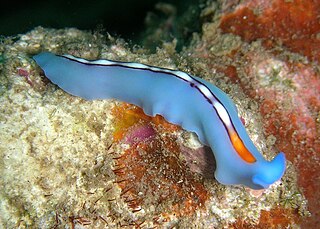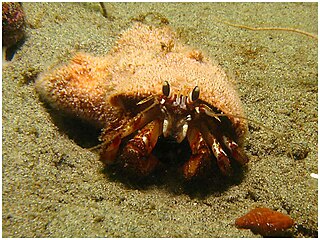
The Terebellidae is a marine family of polychaete worms, of which the type taxon is Terebella, described by Carl Linnaeus in his 1767 12th edition of Systema Naturae.

Idaea, sometimes called Hyriogona, is a large genus of geometer moths. It was erected by Georg Friedrich Treitschke in 1825. They are found nearly worldwide, with many native to the Mediterranean, the African savannas, and the deserts of western Asia.

The Polyceridae are a taxonomic family of sea slugs, dorid nudibranchs, marine gastropod mollusks within the superfamily Polyceroidea.

Pseudoceros is a genus of the flatworms Platyhelminthes.

Karl Georg Friedrich Rudolf Leuckart was a German zoologist born in Helmstedt. He was a nephew to naturalist Friedrich Sigismund Leuckart (1794–1843).

Pagurus is a genus of hermit crabs in the family Paguridae. Like other hermit crabs, their abdomen is not calcified and they use snail shells as protection. These marine decapod crustaceans are omnivorous, but mostly prey on small animals and scavenge carrion. Trigonocheirus and Pagurixus used to be considered subgenera of Pagurus, but the former is nowadays included in Orthopagurus, while the latter has been separated as a distinct genus.

The thorny-headed worm family Polymorphidae contains endoparasites which as adults feed mainly in fish and aquatic birds. When this taxon was erected by Meyer in 1931, a subfamily Polymorphinae was established in it. As the Polymorphidae as presently understood would then be monotypic, with no basal genera outside the Polymorphinae, the proposed subfamily is redundant for the time being and therefore most modern treatments simply omit it. Polymorphus minutus is an economically significant parasite in goose and duck farming.

Corallimorpharia is an order of marine cnidarians closely related to stony or reef building corals (Scleractinia). They occur in both temperate and tropical climates, although they are mostly tropical. Temperate forms tend to be very robust, with wide and long columns, whereas tropical forms tend to have very short columns with a wide oral disc and very short tentacles. The tentacles are usually arranged in rows radiating from the mouth. Many species occur together in large groups, although there are recorded instances of individuals. In many respects, they resemble the stony corals, except for the absence of a stony skeleton. Morphological and molecular evidence suggests that they are very closely related to stony corals.

Chromodoris is a genus of very colourful sea slugs or dorid nudibranchs, marine gastropod molluscs, and the type genus of the family Chromodorididae. Within the genus Chromodoris, there are currently 101 classified species. Species within Chromodoris are commonly found in tropical and subtropical waters, living as members of reef communities and preying primarily on sponges. A molecular phylogeny of the family Chromodorididae resulted in this genus being restricted to a smaller number of species than formerly, most of which have longitudinal black lines on the mantle. Many former members of Chromodoris were transferred to Goniobranchus

Doris is a genus of sea slugs, specifically dorid nudibranchs. These animals are marine gastropod molluscs in the family Dorididae.

Leptostales is a genus of moths in the family Geometridae.

Echinorhynchus is a genus of acanthocephalan parasitic worms. They parasitize a wide variety of fishes from both marine and fresh waters. The intermediate host is usually a crustacean.

Gymnodoris is a genus of sea slugs, dorid nudibranchs, shell-less marine gastropod molluscs in the family Polyceridae.

Plocamopherus is a genus of sea slugs, specifically nudibranchs, shell-less marine gastropod molluscs in the family Polyceridae, subfamily Triophinae. A unique character of Plocamopherus species is a globular bioluminescent organ at the tip of the pair of appendages which are placed just behind the gills. Many species are known to be nocturnal and several are from deep water. They feed on bryozoans.

Goniobranchus is a genus of sea slugs, dorid nudibranchs, shell-less marine gastropod molluscs in the family Chromodorididae.

Myzostoma is a genus of marine worms in the family Myzostomatidae. They are parasitic on crinoids.

Chimaericola leptogaster is a species of polyopisthocotylean monogenean in the family Chimaericolidae. It is ectoparasitic on the gills of the chimaera Chimaera monstrosa.
Tetrabothrius is a genus of flatworms belonging to the family Tetrabothriidae.

Ochetostoma is a genus of echiurans belonging to the family Thalassematidae.

















